Grounding the bath in the apartment: why and how to properly ground the bath
Due to the fact that the bathroom appliances are constantly in conditions of high humidity, the bathroom is considered one of the most dangerous places in the apartment in terms of safety. Any electrical appliance can cause current leakage.
And if someone touches an object under tension, the consequences can be disastrous. Grounding a bathtub in an apartment is a simple procedure, but it can save a person’s life and health. This is the question we will consider in our article. We will analyze in detail the reasons why it is necessary to do grounding.
We also provide detailed instructions for self-earthing of the bathtub, supplementing the material with visual photos and video recommendations.
The content of the article:
What is grounding and why is it needed?
Before starting work, you need to understand the theoretical part of the question. What does the concept of "grounding" mean, is it really necessary and why is this question so acute in the bathroom. This knowledge will help you figure out if you really need to ground the bath in the apartment.
Explanation of the concept of "grounding"
Electric current is a rather dangerous thing, especially when mismanaged. Is it worth mentioning that in combination with water, completely harmless electrical appliances get out of control and become deadly.
We know from the course of physics that current always moves along the path of least resistance. The task of grounding is to work so that even with an unexpected breakdown of an electrical appliance, a person who is near it at that moment will not be injured.
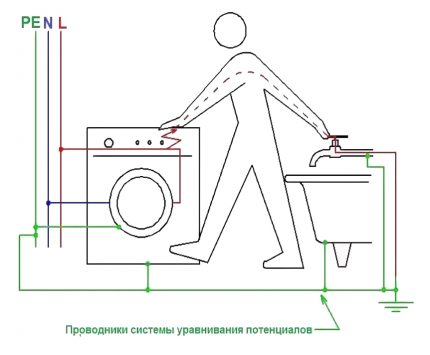
Earth can play the role of zero potential. This property makes it possible to safely use electricity in the home.“Grounding” means connecting the wiring network to the ground with a suitable conductor.
Often in apartments it is quite difficult to perform such an operation, especially in high-rise buildings. Use another method - zeroing.
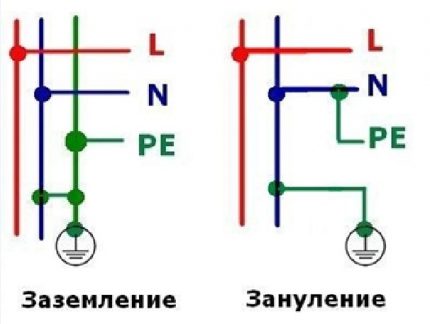
This is a fairly popular method, but there is a significant drawback. The machine does not work instantly. That is, between a theoretical electric shock and a knockout RCD some time passes, albeit in a fraction of a second. If the voltage is high, and the path of electric current passes through the heart, even a second can become fatal.
It is much safer to still ground, although it is more difficult to implement. The potentials in the chain formed between the phase and the earth are instantaneously equalized, and nothing threatens the person.
Why do I need to ground the bath in the apartment?
Based on the foregoing, grounding appliances in the bathroom is a common safety measure, which should be done by default. Unfortunately, modern apartments rarely have proper grounding. Not everyone understands what it is and why it is needed in the bathroom.
Previously, when the water pipes were exclusively metal, the issue of grounding was not at all. Without exception, all the baths were somehow connected to the pipeline, and that, in turn, went underground, thus creating that same grounding.
Now steel pipes are abandoned in favor of plastic ones. Even if you still have a metal pipe, you cannot be sure that the neighbors below have not changed their part of the riser, thus breaking the chain. Therefore, it is better to play it safe and secure yourself and your family.
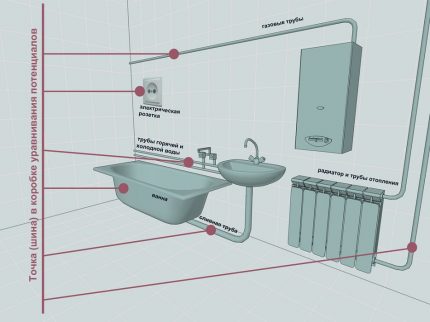
In addition, in those days when many apartment buildings were being built, there were practically no electrical appliances in the bathroom. Even an elementary socket was a rarity.
Now, in an average bath, you can count about 5 permanent electrical appliances:
- electric water heater;
- Washer;
- heated towel rail;
- hair dryer;
- electric shaver.
Any of these and other devices can cause voltage on its body. The consequences can be dire. It is better not to neglect the grounding device before dangerous situations arise.
Features of grounding bathtubs from different materials
Steel or cast iron bathtubs are an excellent conductor. It is these models that need to be grounded first. The old-style bowls are connected with a ground wire for a metal leg. To do this, a hole is drilled in the latter and a special plate is installed - the grounding jumper.
More modern models are already equipped with an overlay on the body - a petal - even at the stage of release from the factory.

The acrylic bath is made of a polymer material, which in itself is not an electric current conductor. However, acrylic has the ability to accumulate static electricity.
Some models are designed in such a way that the bowl is held by a steel or aluminum frame, which must be grounded.

Hot tubs or jacuzzis are equipped with a jet system through which water is supplied under different pressures. For the bath to work, you need a pump. And its power is supplied from an electrical outlet of 220 V.
In addition to the mandatory rules for connecting this kind of bathtubs, such as safe installation of outlets in the bathroom (no closer than half a meter from the edge of the bowl and ground level and the presence of protection not lower than IP44), you must also ground the bath itself, just in case.
DIY grounding instructions
When with theory everything fell into place, it's time to start practice. The issue of grounding in an apartment can be a serious problem if the house does not have a grounding circuit. But this is easily corrected, if there is a desire and opportunities. Choose the right materials and tools, and then do the installation of the wire.
Step 1 - choosing materials before starting work
First you need to decide what materials to purchase for electrical work. After all, it is necessary to choose the right cross-sectional area of the wire, its type, not to be mistaken with the amount of consumable.
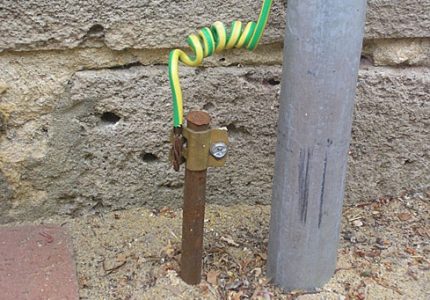
In addition to this basic element, you will need:
- potential equalization box;
- RCD for the right amount of Amps;
- terminals
- pipe clamps.
The potential equalization box is a plastic compartment in which all branches of the ground wire are connected.
Since it is forbidden to ground objects sequentially, a separate cable must go from each device or pipe to the potential equalization box (PLC).

RCD (residual current device) is not installed in the bathroom. Its place in the hallway or in another dry, safe place. It is advisable to familiarize yourself with possible schemes and RCD connection rules.
For apartments, most often choose an RCD for 10 or 16 A, but if you have electrical appliances of increased consumption, such as an electric oven or a flowing water heater with high performance, this protection may not be enough. We advise you to see practical recommendations on RCD selection.

Above mentioned terminals - These are special connections that allow you to accurately and culturally connect the wire to the petal of the bath. This type of connector has a variety of shapes.
Clamps are needed for those cases when, in addition to the bathtub, you want to separately ground the pipeline.
Step 2 - preparing the tool for electrical work
The set of necessary tools for laying grounding in the bathroom is not very different from the standard set of an electrician.
You don’t have to buy anything new or specific, just take care of:
- screwdriver;
- wrench;
- drills and drills for metal;
- a flashlight;
- tester or multimeter;
- welding machine (optional);
- protective equipment (extremely necessary).
The most popular tool in the home master’s box is a screwdriver. Electrical work is best done with an indicator screwdriver. A light bulb is hidden in her handle, which lights up when a screwdriver touches a live element.
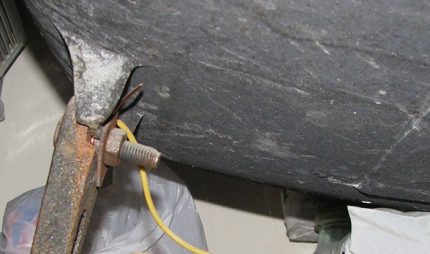
A wrench is needed to tighten the bolts when connecting the ground wire to metal plates.
A drill will be needed if the manufacturer does not provide a special hole for cable entry or the bath model is too old.
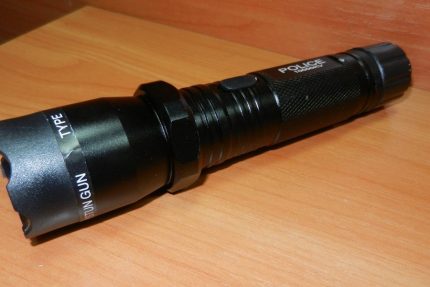
Tester or multimeter - devices that allow you to measure the magnitude of the voltage in the circuit. It is especially important to have one of these devices in the case when you do not know for sure whether there is grounding in your outlet or not.
A welding machine will be needed when you decide to install a ground loop on the street. It is necessary to weld the steel structure reliably, if you do not have experience and relevant skills, the welding machine may not be enough, and a qualified welder will be needed.

Before grounding the bathtub in your apartment, prepare tools only with handles made of dielectric materials, additionally check for voltage in the circuit even when the power is turned off, post a warning notice on the electrical panel so that someone does not accidentally turn on the machine.
Step 3 - laying a ground bus for the apartment
Ideally, an apartment building should have a common grounding bus, to which any resident can connect and ground. In practice, common house grounding is a huge success, it is very rare.
If you are lucky and the management company of your home, the developer or active tenants who are aware of the danger and responsibility of using electrical appliances in the bathroom, have installed a ground loop, you can connect all your dangerous electrical appliances, metal pipes and a bath directly to it through the electrical panel on the floor.
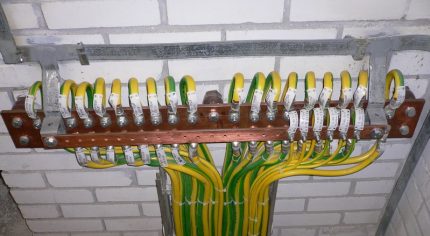
If nobody still takes care of your house, you will have to do it yourself.
And there are several options:
- ask to do grounding of the Criminal Code or city authorities;
- convince other tenants and pay for installation from your pocket;
- take care of your safety and make an individual ground loop on your own.
In the last two cases, you will need to hold a copper wire of at least 6 mm2 thick throughout the riser to the basement.
Then, near the house in an open, preferably fenced and uninhabited area, a pit about 1.5 m deep is made. Three thick electrodes are placed vertically in this pit - most often they use steel metal or reinforcement.

Three racks are connected from above by a steel strip using a welding machine or a thick wire, so that a closed triangular contour is obtained.
Then they remove the ground wire, lay it underground in a special protective sleeve. The wire is connected to the metal structure. Thus, a common, fairly reliable and durable grounding loop is obtained, which can be used by all residents of the apartments in a riser.
The steps for installing a ground loop next to a high-rise building are similar to installing such a loop in a private house. If you still decide to do it yourself, we recommend that you familiarize yourself with useful tips on circuit design and installation.
Step 4 - grounding all appliances in the bathroom
After you have made sure that your home has grounding and found how to connect to it, the further process will not cause difficulties.
- Select a location for the potential equalization box. It should be located on a dry wall, away from the bath.
- If the bathtub is new, it should be turned over for convenience. Often, grounding is remembered when the bathtub is not just mounted, but also laid with tiles, hidden behind a screen or decorative panel. Then the work will be a little more difficult.
- Decide where exactly the cable will be connected. Find the place provided by the manufacturer. As a rule, this is a plate with a hole welded or screwed to the body.
- If there is no special grounding point, use a drill. Drill a small hole in the metal part. If it is cast iron, most likely, at the bottom of the bowl there are inflows that should ensure the stability of the structure on the legs. These influxes can be used for grounding.
- Route the wire along the wall from the point of connection to the PMC.
- Using a terminal, connect one end to the plate in the potential equalization box, and the other to the bath body through the drilled hole.
- Connect the PMC to the ground bus in the switchboard with a copper wire of sufficient thickness.
- Then you need to check the connection and hide the wire. This is done not only for aesthetic purposes, but also in order not to accidentally damage the cable.
After installation, you need to check the grounding with the tester. To do this, connect the phase and the grounded bath. If the tester lamp is lit brightly, it means that the current will go along this circuit in case of an accident and will not touch a person.
Conclusions and useful video on the topic
Videos with answers to most popular questions will help to finally close the question of the need for grounding in the bathroom. If it’s easier for you to perceive the information in video format, this collection will certainly help you.
Why ground a steel bath in an ordinary apartment:
How to organize grounding in an apartment building:
How to make grounding in the bathroom:
After all of the above, it becomes clear why grounding a metal or acrylic bath. Usually this work takes very little time, subject to the availability of common house grounding. A few simple operations - and your bathroom becomes a safe room without the risk of electric shock.
Thinking about whether to ground the bath? Or have you already gathered to carry out grounding, but you have questions that we did not cover in this article? Ask them in the block under this article.
Or do you have the theoretical knowledge of grounding a bath and want to share it with other users? Maybe you noticed an inaccuracy or mistake in our article? Let us know in the comments below.

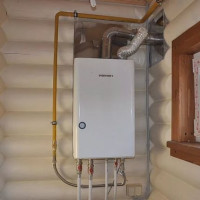 How to make grounding for a gas boiler: grounding requirements and installation instructions
How to make grounding for a gas boiler: grounding requirements and installation instructions  How to make a ground loop in a private house with your own hands: grounding schemes and installation instruction
How to make a ground loop in a private house with your own hands: grounding schemes and installation instruction 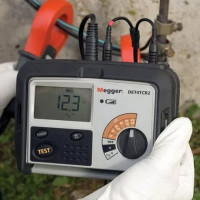 Earth resistance measurement: a review of practical measurement methods
Earth resistance measurement: a review of practical measurement methods  How much does it cost to connect gas to a private house: the price of organizing gas supply
How much does it cost to connect gas to a private house: the price of organizing gas supply  The best washing machines with dryer: model rating and customer tips
The best washing machines with dryer: model rating and customer tips  What is the color temperature of light and the nuances of choosing the temperature of the lamps to suit your needs
What is the color temperature of light and the nuances of choosing the temperature of the lamps to suit your needs  Replacement of a geyser in an apartment: replacement paperwork + basic norms and requirements
Replacement of a geyser in an apartment: replacement paperwork + basic norms and requirements
Undoubtedly, a modern bathroom in an apartment is an increased source of danger in terms of increased likelihood of electric shock. Therefore, the installation of all electrical devices must be performed in accordance with all the rules. Sockets - only waterproof, lamps - tight. It is imperative to install an RCD and an automatic switch for wiring to the input of the bathroom's power lines. If the house does not have grounding, do not be too lazy to drive the armature into the ground and ground at least your apartment through it.
In order to use the bathtub safely, be sure to ground it. Of course, this will require certain efforts from you, because in modern multi-storey buildings with common grounding, things are not in the best way. The use of water pipes is unreliable, the clamping area gradually rusts, it gradually weakens, it bursts when heated. Or someone inserted a plastic pipe.
First of all, inspect the electrical panel on your floor. If you see a thick bare wire, rejoice, this is the common ground. Lay a three-core cable into the apartment, and then a matter of technology. Not found, cooperate with neighbors, lay ground wires to all floors with the installation of terminal blocks on each floor. In the basement, inspect the general electrical panel, according to the rules of the PUE (GOST for electricians) it must be grounded! Otherwise, hammer three metal rods into the ground, weld with a strip, weld a connecting bolt, attach a common ground wire, at the same time and an electrical panel. And you will be happy.
How to ground the bath will save you from breakdown on the shaver or hair dryer?
It will save if any goat has grounded its electrical network on the water supply system and is piercing it with a casing. Such freaks are especially common among hams and electronics.
Then, when you turn on the water, it will shock you, RCDs for such individuals are usually not worth it, all live parts, including water from the water supply, conducts current and are under potential.
Good day, Andrey.
The theme of grounding baths is actually related to potential equalization. For example, you have a metal bath, metal water pipes, a metal drain into the sewer.
If there is no potential equalization system, then getting up under the shower can get an electric shock. This is the case when the "goats" mentioned in the posts arrange the local "land" through the water supply.
It will save you, I note, in this case, not the grounding of the bath, but the metal connection of the bath, drain pipe, water pipes. If the house is operated according to the PUE, then all the pipes at the “level” of the input switchboard are connected to a single bus that has a ground connection.
A very dangerous case is when the bathtub is grounded, and the washing machine, standing on insulated legs, has reduced electrical insulation. Simultaneous contact of the washing machine body and the bath body can end sadly. Similarly, in the kitchen - the combination “refrigerator with poor insulation near the sink” is also dangerous.
However, the majority of problems are removed by RCDs - read the section of this site “RCD and machines».
Great photo on the grounding of the pipe. Metal ring through the gasket.
Probably a radio amateur did.
And what did you fasten on hams and electronics? It doesn’t get to your chicken brains that if a person understands electronics, then he MORE ACCEPTED IN ELECTRICIAN ?!